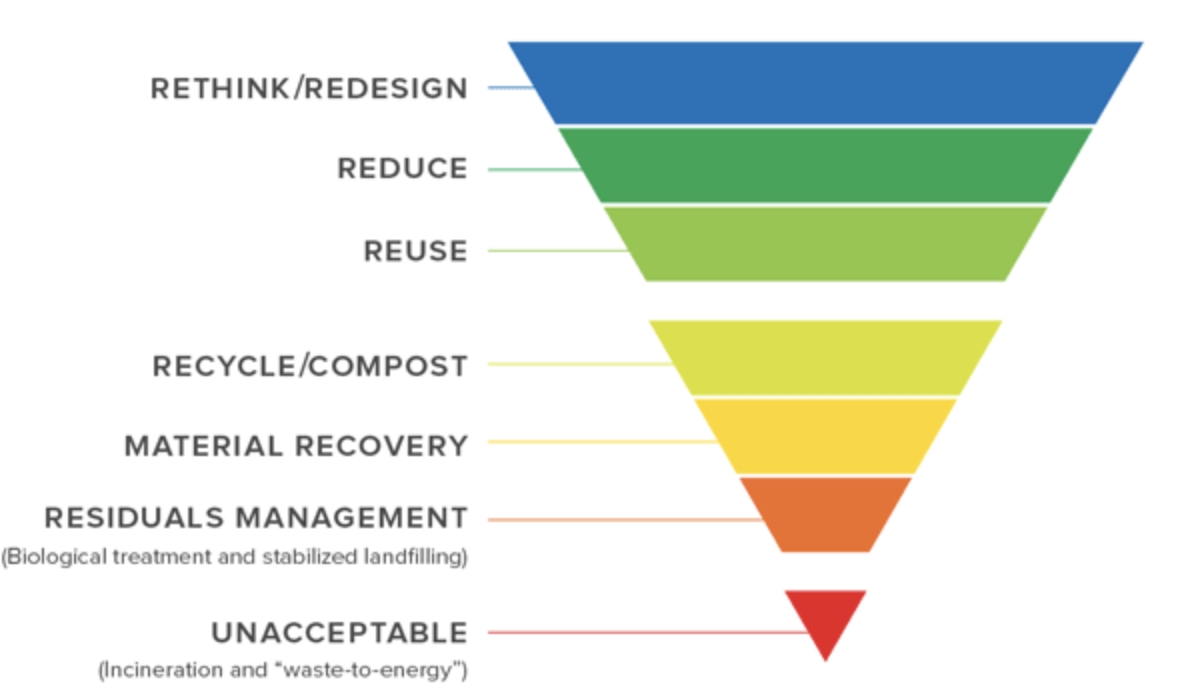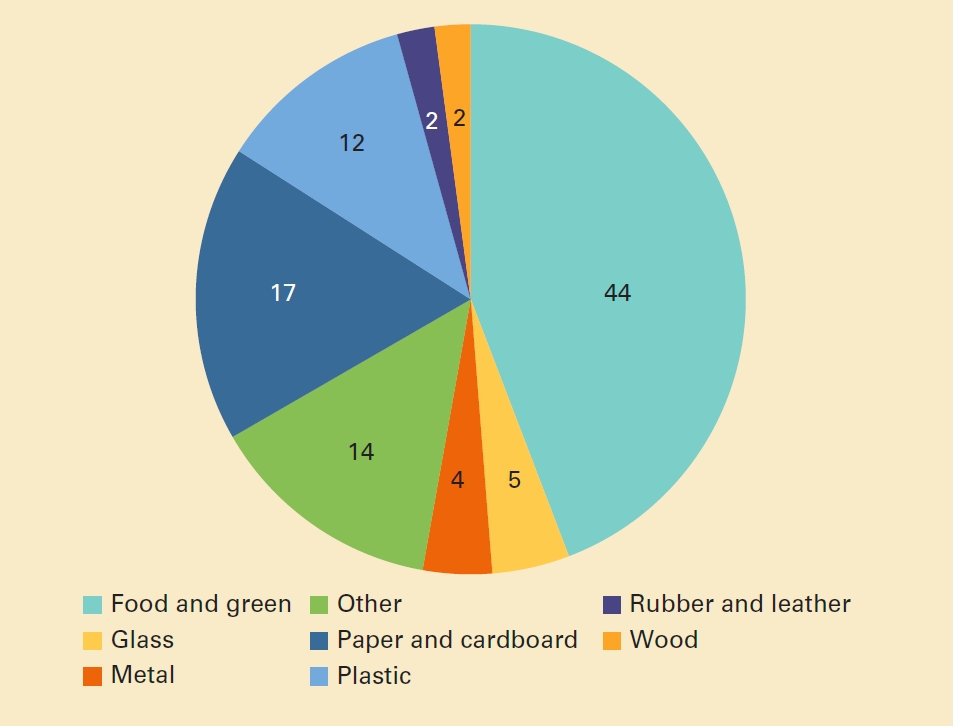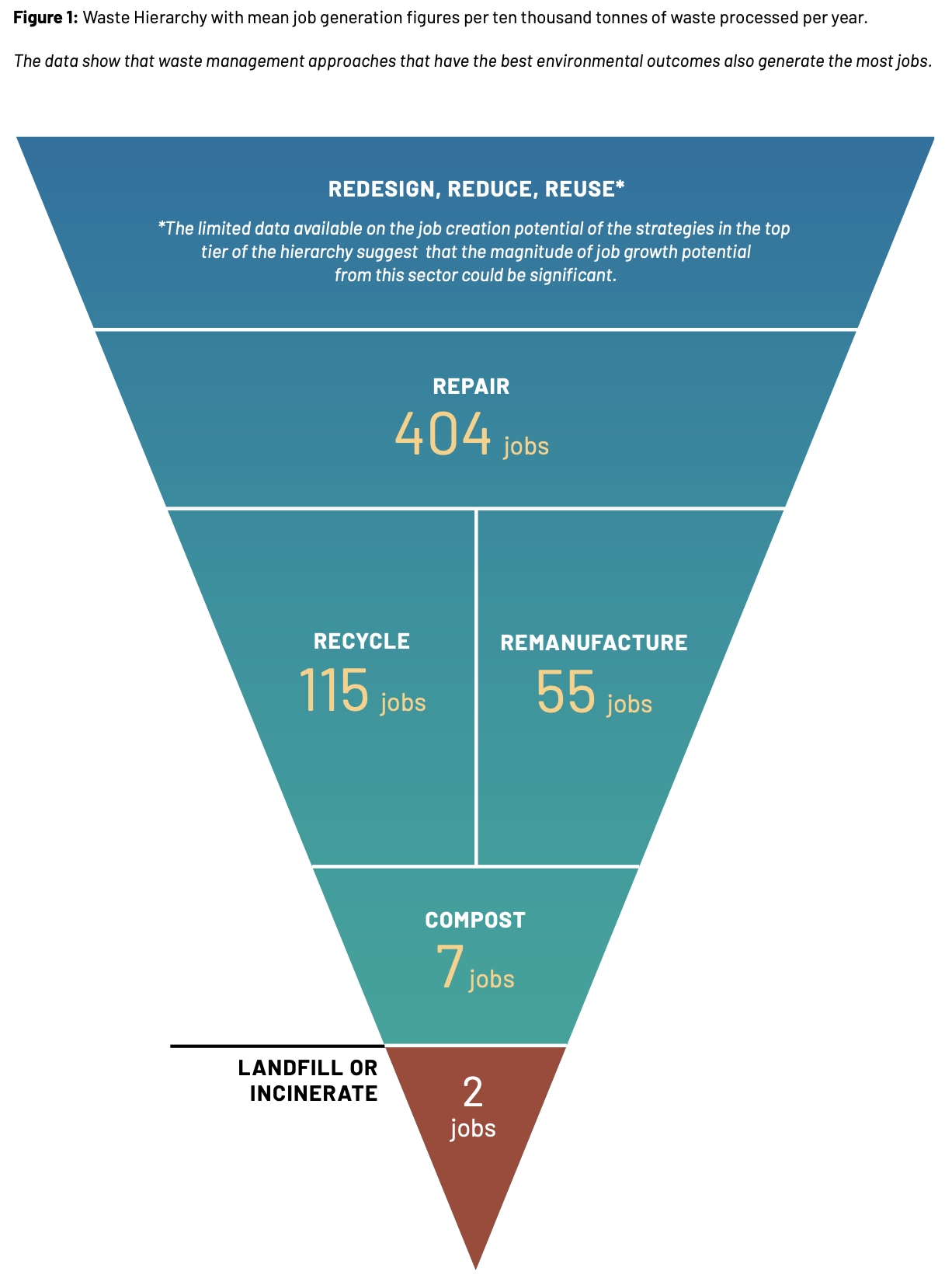What is Zero Waste?
As discussed earlier, our current global economy manages resources very inefficiently. More than 80% of the materials and products we source and use are wasted, either because they cannot be recycled due to cost or physical properties, or because we are unable to recover them economically for reuse or recycling. This situation, while tragic and unacceptable, offers a great opportunity to change the course of the future and to bring our planet’s ecosystems back into balance. Choosing better materials, redesigning products for durability and recyclability, improving incentives for waste sorting, recovery and recycling, and introducing new business models such as product-as-a-service[31] that include recycling in the service, offer great promise to dramatically reduce waste on a global level and directly or indirectly help to regenerate our planet.
Following is the peer reviewed definition of Zero Waste first established by the Zero Waste International Alliance (ZWIA) in 2004 and more recently updated in December of 2018. [32]
“Zero Waste: The conservation of all resources by means of responsible production, consumption, reuse, and recovery of products, packaging, and materials without burning and with no discharges to land, water, or air that threaten the environment or human health.”
The above definition highlights two existing solutions that prevent products and materials from being recovered and recycled, competing directly with establishing a zero waste, low-carbon circular economy. They are landfilling and incineration. Hence the motto “No Bury, No Burn”. The new definition also recognizes the responsibility that producers and consumers have in preserving resources, emphasizing the need for changing existing business practices and consumer behavior. The solutions can include redesign of products to make them easier to be reused and recycled, improving purchasing policies to reduce waste in supply chains and sourcing of material inputs that can only be acquired through new raw material extraction, and better consumer decision-making, opting for products that are more recyclable. These could include incentives for opting for glass and aluminum packaging over plastic, or using compostable packaging instead of plastic for single-use applications.
The Zero Waste definition aligns with the Zero Waste Highest and Best Use Hierarchy[33]:

Zero Waste is a goal. Institutions that offer Zero Waste certification such as ZWIA, the US Green Building Council under its TRUE (Total Resource Use and Efficiency) program, and others, set a minimum 90.1% waste diversion requirement from landfills, incinerators and the environment for certification. This means that more than 90.1% of post-industrial and/or post-consumer waste is recovered for future use through recycling, composting, and other processes. While 90.1% diversion rate may seem daunting when compared to existing global recycling averages, most businesses, communities and households can reach zero waste easily and quickly, while others can do so with a little more effort. Below is a description of TRUE’s Credits for waste diversion performance.[34] Note that TRUE even has a credit for 100% diversion rate, which suggests that anything is possible!

Studying waste composition helps to explain the journey to Zero Waste. The pie chart below shows Global Waste composition in percentage terms[35].

Note that approximately 50% of total waste globally, measured in weight, is organic matter. Food waste in households in developed countries usually have a slightly lower than 50% composition because of higher consumption of physical goods while poorer countries have a higher than 50% composition due to lower consumption of physical goods. Restaurants can have up to 70% of their waste weight be of organic nature. Because organic waste is 100% recyclable if directed to composting facilities, it becomes the first critical step toward achieving Zero Waste performance, while closing the loop on the circular carbon and food cycles. But, removing food and organic waste from the linear trash stream also has a significant added benefit to the recoverability performance of recyclables. When recyclable products and materials reach sorting facilities free from food waste contamination, recycling performance of existing waste volumes typically improves by a factor of 2-4X going from less than 20% to north of 80%. This occurs because in most jurisdictions cleaning recyclables is either too cumbersome or expensive, not to mention that it exposes sorters to unsanitary work conditions. Improving recycled material sales from existing volumes goes directly to the sorter's bottom line. The volume of recyclable materials recovered in a region, city or municipality also increases significantly when independent food and green waste collection hauling operations are introduced, because sorting is simplified.
Another waste stream that typically enhances overall recycling performance when sorted at source is Glass. Cullet, or glass waste, is 100% recyclable and yet recycling rates are typically very low, especially in low and middle-income economies that depend on pickers for waste pickup. The reason is that pickers only collect what they can carry and sell at a rate that justifies their physical work. Glass bottles are heavy and when broken become a hazard for manual laborers. In such cases, sorting glass at the source and generating independent logistical routes that send cullet directly to glass making factories is ideal.
The combination of removing a hazard (glass) and a contaminant (food) from the traditional mixed waste hauling streams leads to exponential improvement in recycling rates at the local level and can lead to a high level of Zero Waste performance. For markets that depend on pickers to perform much of the work, removing food waste and glass from existing waste streams is critical to increasing quality and quantity of available recyclable materials and should be viewed as a solution that works in parallel with pickers rather than in competition with them.
Zero Waste projects can start locally and independently. One example is the Zero Waste Bar & Restaurant network established in the city of Brasília, Brazil by the Ecozinha Institute. Average recycling rates at more than 85 establishments increased from ~3% to 93% in less than 1 year[36]. Roughly US$12,000.00 of new economic activity was generated, 49 new green jobs were created, and 143 tons were diverted from the local landfill each month. A decentralized waste services industry was created with multiple service providers including four composting facilities that collect and compost food waste, one hauler that collects glass, one glass bottling factory that recycles cullet, and one picker that collects and sells recyclables. This was accomplished through the implementation of a Pay-As-You-Throw service where businesses pay for glass and food waste pickup. Glass is collected at the establishment or in shared street bins, and then accumulated at a local site before being shipped 1,163 kms to a glass bottling factory in Rio de Janeiro. A small fee is charged to each establishment at the end of the month to cover local hauling costs, while the glass factory buys the cullet (glass waste) material and covers the cost of long distance hauling. The fee paid by each establishment under this model on a weight basis is roughly in line with local landfill tipping fees (~US$26/ton) and can be below tipping rates for larger volumes, like those generated at bars. Glass at bars can represent as much as 40% of total waste composition. Food waste pickup and composting services also charge on a Pay-As-You-Throw basis according to the total weight of organic waste collected. Fees range from US$64-100 per ton determined typically by distance and frequency of pickup, and can run an establishment anywhere between US$50-400 per month. Food waste collection, hauling and composting is complex and hard work and should be valued for the contribution it brings to society. While the cost to compost on a weight basis is higher than contracting private waste-to-landfill hauling services, the incremental charge is typically small for the business and can be passed on to the consumer. It should be noted that the project benefited from local legislation that requires businesses and commercial and multi-family residential buildings that produce more than 120 liters of waste per day, the equivalent of one large trash bag, to contract with a private waste hauling service to pick up and send waste to the landfill.[37] The Federal District went further in 2020 and passed a law requiring businesses to send organic waste to composting facilities or locations with comparable biological treatment. An outright ban on organic waste entering landfills could be easier to enforce and signal to the private sector the need for decentralized food waste hauling services and composting, and speed up investment. Forcing companies to hire private haulers to pick up waste and send to landfill did, however, establish a floor price for new recycling services to enter the market and compete. The argument made by Ecozinha Institute is that if you have to pay for waste pickup, you might as well pay for recycling. Unfortunately, the model still needs improvement because Waste Management companies contracted by the municipality are paid on a per ton basis of waste tipped at the local landfill. Thus, they have an incentive to pick up as much waste material as possible, including recyclables and organic waste, for free and send it to the landfill. If local authorities fail to perform waste audits and apply fines, businesses will continue to place waste out on the streets for municipal waste managers to collect, hurting existing private market service providers and keeping new entrants at bay. This does not negate, however, the critical role that the Pay-As-You-Throw model introduces. Not unlike paying for use of data or minutes on a mobile plan, or paying for kWh or Gallons/Liter consumed on energy and water bills, each person should pay precisely for the amount of waste they produce. This is the only way to effectively allocate waste responsibility to each individual and business and introduce incentives for waste reduction.
For further reading on community and city projects that have embarked on the path to Zero Waste see Zero Waste Europe’s Master Plan and case studies: Ljubljana, Capannori, Contarina, Parma, Sardinia, Salacea and Milan[38]. In Asia, it is worth noting the achievements of Seoul, Korea with the application of a volume-based waste disposal fee program (another term for Pay-As-You-Throw) paired with Extended Producer Responsibility, as well as smaller examples of decentralized initiatives in Tacoblan and San Fernando in the Philippines where waste management responsibilities are placed at the barangay (community) level.
A highly-performing, Zero Waste Circular Economy is also a great job creator, evidenced by the Ecozinha Institute case described above and according to a report published by Gaia[39], which suggests that more than 200X jobs can be created in a Zero Waste economy for every one job created in a landfill or incineration plant. The diagram below shows the areas of the economy that benefit the most, comparing composting, recycling, remanufacturing, repair and redesign, reduce and reuse, to landfilling and incineration. The data in the report shows that waste management approaches that have the best environmental outcomes also generate the largest number of new jobs.

In conclusion, while a Zero Waste Economy is critical to our path to resource sustainability and ending pollution, and can result in multiple benefits including green jobs, improving business performance and savings to municipalities, many impediments remain. Landfills and Waste to Energy incineration plants compete directly with recycling and composting. Sale value of many recyclable materials often don’t compensate for the cost of capturing, sorting and hauling of waste materials. Because of this, a new approach is required that connects all stakeholders in a manner that each participant can pay for the amount of waste they generate and when necessary, utilize an offset mechanism that enables companies to efficiently invest back into the recycling economy without over-regulation or taxation. Market forces by waste type need to be applied to optimize resource recovery and reuse. All participants must come together to share the burden and work together to address the waste problem, including producers (raw material providers, converters, packers/fillers and sellers). We will dive a little deeper into Extended Producer Responsibility as it is a key component of the Zero Waste Economy and of the $CARROT ecosystem solution.
31. Ellen MacArthur Foundation - What if we Don’t Buy Products and We Buy Services? (video)
32. Zero Waste International Alliance - Zero Waste Definition
33. Zero Waste International Alliance - Highest and Best Use Hierarchy
34. Green Building Certification Institute: TRUE Rating System, Updated June 2020, p.10
35. World Bank: What a Waste 2.0 report - Global Waste composition
36. GIZ/PROTEGEER Report, April 29, 2020 - “Good Practices in Urban Solid Waste Management” in portuguese, p.14
37. Brazil’s Federal District “Large Waste Generator Law”: LEI Nº 5.610, DE 16 DE FEVEREIRO DE 2016
38. Zero Waste Europe - #ZeroWasteCities website.
39. GAIA - Zero Waste and Economic Recovery report, The Job Creation Potential of Zero Waste Solutions
Last updated